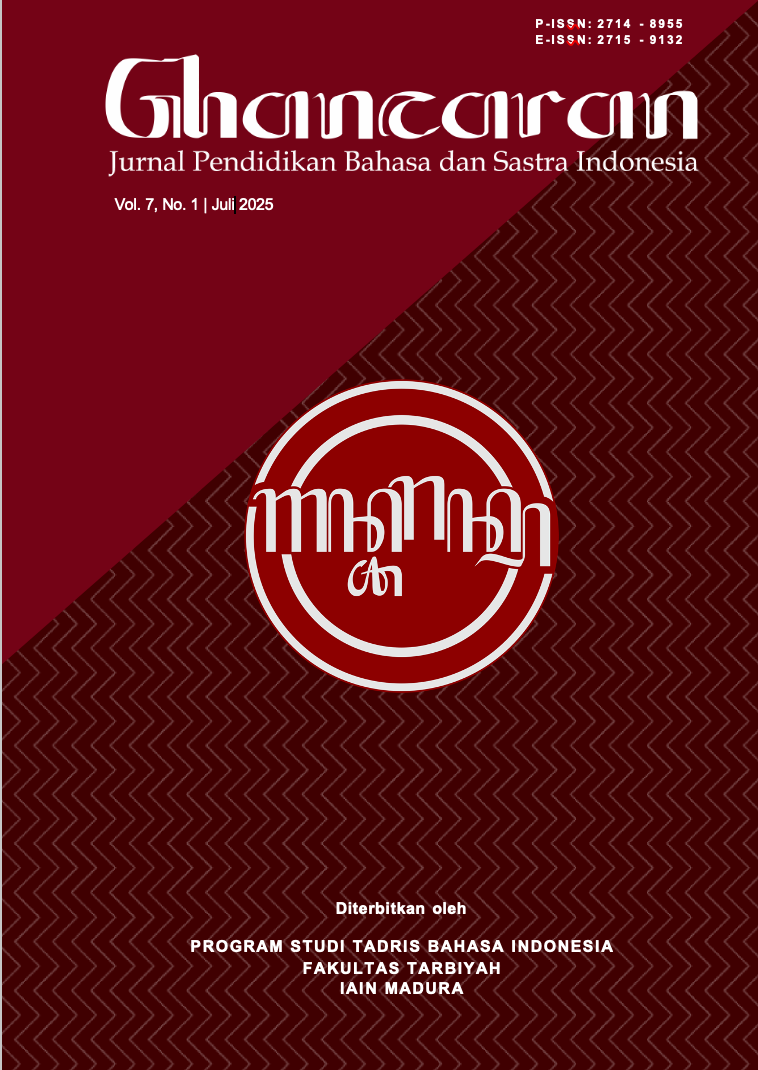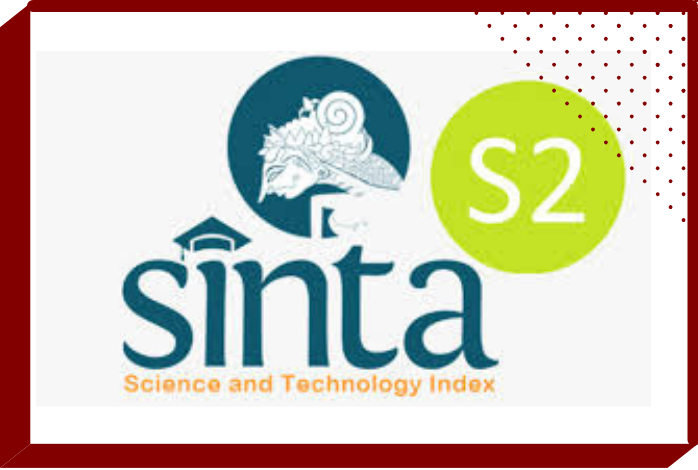The Extinction of Local Languages in Indonesia and Strategies to Overcome (Comparative Study in West Kalimantan and North Maluku)
 Abstract views: 428
,
Abstract views: 428
,
 PDF downloads: 468
PDF downloads: 468
Abstract
The extinction of local languages in West Kalimantan and North Maluku is a growing concern. This study address the following questions: 1) How diverse are the local languages in West Kalimantan and North Maluku? 2) What is the current condition of these local languages? 3) How can the extinction of these languages be prevented? This research utilizes a comparative study method with a descriptive qualitative approach, focusing on the status of local languages in these regions. Data was collection through literature review, observation, interviews, and documentation. The findings indicate that many local languages in these areas are on the brink of extinction, primarily due to the diminishing number of speakers. Additionally, the dominance of the national language, Indonesian, has pushed local languages aside, especially among the younger generation who prefer using Indonesian in daily interactions. Despite this, the use of local languages remains strong within families and communities If immediate action is not taken, these languages will likely become extinct in the coming decades. This research emphasizes the need for proactive measures to preserve these languages.
Downloads
References
Adli, A., & Guy, G. R. (2022). Globalising the Study of Language Variation and Change: A Manifesto on Cross‐Cultural Sociolinguistics. Language and Linguistics Compass, 16(5–6), 1-15.
Ahearn, L. M. (2021). Living language: An Introduction to Linguistic Anthropology. John Wiley & Sons.
Aji, A. F., Winata, G. I., Koto, F., Cahyawijaya, S., Romadhony, A., Mahendra, R., Kurniawan, K., Moeljadi, D., Prasojo, R. E., & Baldwin, T. (2022). One Country, 700+ Languages: NLP Challenges for Underrepresented Languages and Dialects In Indonesia. ArXiv Preprint ArXiv:2203.13357.
Alam, M. K. (2021). A Systematic Qualitative Case Study: Questions, Data Collection, Nvivo Analysis and Saturation. Qualitative Research in Organizations and Management: An International Journal, 16(1), 1–31.
Arafah, B., Hasjim, M., & Arafah, A. N. B. (2023). Cultural Relations Among Speakers of South Halmahera Languages. Theory and Practice in Language Studies, 13(1), 168–174.
Arkanudin, A., Rupita, R., & Batuallo, I. D. (2021). An Ethnic Ethnographic Review: The Kinship System of The Dayak Ribun Tribe in West Kalimantan. ETNOSIA: Jurnal Etnografi Indonesia, 6(2), 241–251.
Asteria, D., Brotosusilo, A., Soedrajad, M. R., & Nugraha, F. N. (2021). Reinventarization of Living Procedures, Local Knowledge, and Wisdom to Environment (Study Case on Tobelo Tribe-Halmahera). IOP Conference Series: Earth and Environmental Science, 716(1), 1-7.
Avé, J. B. (2024). West-Kalimantan: A Bibliography. Brill.
Blevins, J., & Kaufman, D. (2023). Lexical Evidence in Austronesian for an Austroasiatic Presence in Borneo. Oceanic Linguistics, 62(2), 366–413.
Bock, C. (2024). The Head Hunters of Borneo. A Narrative of Travel up the Mahakkam and Down the Barito Also, Journeyings in Sumatra. BoD–Books on Demand.
Brisset, A., Gill, R., & Gannon, R. (2021). The Search for a Native Language: Translation and Cultural Identity. In The Translation Studies Reader (pp. 289–319). Routledge.
Chen, J. (2020). The 2018/2019 Simultaneous Elections in West Kalimantan Province and Its Aftermath: Historical Legacies, Identity Politics, and The Politics of Partition. In The 2018 and 2019 Indonesian Elections (pp. 145–166). Routledge.
Collins, J. T. (2022). Language Death in Indonesia: A Sociocultural Pandemic. Linguistik Indonesia, 40(2), 141–164.
De Wilde, V., Brysbaert, M., & Eyckmans, J. (2020). Learning English Through Out-of-School Exposure. Which Levels of Language Proficiency are Attained and Which Types of Input are Important? Bilingualism: Language and Cognition, 23(1), 171–185.
Doerr, N. M. (2024). Language Standardization and Counter-Standardization: Theories, Minority Empowerment, and Language Education. Counterstandardization and Post Unit-Thinking: Imagined Fluid, Diverse, and Dialogic Language beyond Standard. Mouton de Gruyter.
Endardi, J., Kasnowihardjo, G., Kurniawati, W., Sukesti, R., & Sa’diyah, U. (2023). Trace the Traces of Austronesian Culture and Language Families in the Java Sea Area: Connectivity Between Bawean, Rembang, and Sampang. 3rd International Conference on Linguistics and Cultural (ICLC 2022), 225–250.
Espree-Conaway, D. A. (2022). Evolutionary Cartographies of Language Diversification: Quantitative Approaches to the Geolinguistic Mapping of the Kayanic Languages (Central Borneo). The University of North Dakota.
Evans, N., Arka, W., Carroll, M., Choi, Y. J., Döhler, C., Gast, V., Kashima, E., Mittag, E., Olsson, B., & Quinn, K. (2018). The Languages of Southern New Guinea. The Languages and Linguistics of New Guinea: A Comprehensive Guide, 641, 774.
Fatmawati, E. (2021). Strategies to Grow a Proud Attitude Towards Indonesian Cultural Diversity. Linguistics and Culture Review, 5(1), 810–820.
Fowler, R. (2022). Understanding anguage: An introduction to linguistics. Routledge.
Guntur, M., Kurniawan, K. R., & Sutanto, D. (2024). Re-Translation of Dayaknese Vernacular Material Culture into Postcolonial City of Palangka Raya through Urban Physiognomy. In Potency of the Vernacular Settlements (pp. 162–183). Routledge.
Hull, T. H. (2022). 4 The Importance of The 2020 Population Census for Health Data. In Sickness and In Health: Diagnosing Indonesia. Iseas Publishing.
Irawan, Y., Kurniasari Febrianti, B., Marwanto, M., & Agus Kurnianto, E. (2021). Tuah Talino: Menggalang Makna dalam Karya Jurnal Ilmiah Bahasa dan Sastra. In Tuah Talino (Vol. 15, Issue 1). Balai Bahasa Provinsi Kalimantan Barat.
Istianah, A., & Suhandano, S. (2022). Appraisal Patterns Used on the Kalimantan Tourism Website: an Ecolinguistics Perspective. Cogent Arts & Humanities, 9(1), 1-16.
Leonard, W. Y. (2023). Challenging “Extinction” Through Modern Miami Language Practices. In Global Language Justice (pp. 126–165). Columbia University Press.
Li, Z., & Bonk, C. J. (2025). Self-Directed Language Learning with Duolingo in an Out-of-Class Context. Computer Assisted Language Learning, 38(3), 569–591.
Lumwanga, C. R. (2023). A Comparative Study of Bemba and Mambwe at Phonological, Morphological and Lexical Levels. The University of Zambia.
Maggalatung, M., Ridwan, M., Syarifudin, S., Darma, D., & Sulaeman, S. (2021). Reviewing Sepa Language Extinction of the Indigenous Peoples of Amahai, Moluccas, Indonesia. Technium Social Sciences Journal, 22, 778-789.
Martono, M., Dewantara, J. A., Efriani, E., & Prasetiyo, W. H. (2022). The National Identity on The Border: Indonesian Language Awareness and Attitudes Through Multi‐Ethnic Community Involvement. Journal of Community Psychology, 50(1), 111–125.
Muhamad, H. H., Abdullah, W., Purnanto, D., & Marmamto, S. (2022). Honorific Rules for Alternation of Kinship Greetings of the Taba Language in North Maluku, Indonesia. Journal of Positive School Psychology, 6(8), 6375–6390.
Mu’ti, A. (2025). Local Wisdom-Based Multicultural Education: Muhammadiyah Experience. Intellectual Discourse, 33(1), 183-200.
Nguyen, T. T. T., & Hamid, M. O. (2021). Language Choice of Vietnamese Ethnic Minority Students in Family and Community Interactions: Implications for Minority Language Maintenance. International Multilingual Research Journal, 15(4), 317–331.
Patriantoro, P., & Rahmani, E. F. (2023). Variations of Malay Language in Sintang Raya. Indonesian Journal of EFL and Linguistics, 1–12.
Pepinsky, T. B., Abtahian, M. R., & Cohn, A. C. (2024). Urbanization, Ethnic Diversity, and Language Shift in Indonesia. Journal of Multilingual and Multicultural Development, 45(7), 2503–2521.
Perangin-Angin, D. M., & Dewi, N. (2020). A Study of Pagu Proverbs: Saving an Endangered Language of North Halmahera. Indonesian Journal of Applied Linguistics, 10(2), 327–339.
Purwani, E. S., Sukmana, O., & Salviana, V. (2024). The Threat of Extinction of Lampung Regional Language, Indonesia: A Phenomenological View. International Journal of Research in Engineering, Science and Management, 7(5), 90–96.
Rahman, A., & Umar, J. (2024). Betel Nut and Betel Leaf: Strengthening Social Relations through the Tradition of Chewing Betel in the Islamic Community in Kao Village, North Halmahera. Open Journal of Social Sciences, 12(11), 722–755.
Rigo, A. C. (2021). Minority and Endangered Languages in the World-International, European and National Policies to Counteract Language Death.
Rosiak, K. (2023). The Role of Language Attitudes and Ideologies in Minority Language Learning Motivation: a Case Study of Polish Migrants’(De) Motivation to Learn Welsh. European Journal of Applied Linguistics, 11(1), 26–52.
Schroedler, T., Purkarthofer, J., & Cantone, K. F. (2024). The Prestige and Perceived Value of Home Languages. Insights from on Exploratory Study on Multilingual Speakers’ Own Perceptions and Experiences of Linguistic Discrimination. Journal of Multilingual and Multicultural Development, 45(9), 3762–3779.
Sidi, B. A. (2020). Unity and Diversity: National Identity and Multiculturalism in Indonesia. University of Otago.
Siregar, I. (2022). Effective and Efficient Treatment of Regional Language Preservation Strategies in the Nusantara. Journal of Humanities and Social Sciences Studies, 4(2), 16–22.
Siregar, I. (2023). The Worthy Research Approaches to Endangered Languages. Formosa Journal of Sustainable Research, 2(5), 1299–1314.
Sommerlot, C. J. (2020). On the syntax of West Kalimantan: Asymmetries and A’-Movement in Malayic and Land Dayak languages. The University of Texas at Arlington.
Syarif, Z., & Thabrani, A. M. (2024). Strengthening Religious Moderation through Religious Education Based on Local Wisdom of Pesantren in Madura and the Tapal Kuda Region. TADRIS: Jurnal Pendidikan Islam, 19(2), 104–119.
Taggok, M. I., & Hawari, M. R. (2021). The Traditional Religion of the Dayak in West Kalimantan: Analysis of JU Lontaan’s Monograph. Heritage of Nusantara: International Journal of Religious Literature and Heritage, 10(1), 1–31.
Taher, M. D. S., Oktaviani, V. D., Dewanda, K., Yosafat, V., & Firmonasari, A. (2022). Language Preservation Parameter: Assesment of Bengkulu Malay Language Vitality Using Level Endangerment Index. Tradition and Modernity of Humanity, 2(2), 33–48.
Tartillah, Q. A. (2022). Multiculturalism in Indonesia: How Modern Society Maintains the Tradition of the Ethnic Groups: магистерская диссертация по направлению подготовки: 51.04. 01-Культурология.
Thomann, E., & Maggetti, M. (2020). Designing Research with Qualitative Comparative Analysis (QCA): Approaches, Challenges, and Tools. Sociological Methods & Research, 49(2), 356–386.
Timothy, C. B. (2020). Language Contact in North Sulawesi: Preliminary Observations. Tokyo University of Foreign Studies.
Ufie, A., Oruh, S., & Agustang, A. (2021). Maintaining Social Harmony Through Historical Learning Based on Local Wisdom of Indigenous Peoples in Maluku. Historia: Jurnal Pendidik dan Peneliti Sejarah, 5(1), 27–36.
Vidal, J. (2023). Fevered Planet: How Diseases Emerge when We Harm Nature. Bloomsbury Publishing.
Wang, L. (2020). Rivers of Dayak Dreams: The Aporia of Knowledge and the Melancholia of Race in Three Memoirs about Borneo. University of Washington.
Weidinger, T., & Kordel, S. (2023). Access to and Exclusion from Housing Over Time: Refugees’ Experiences in Rural Areas. International Migration, 61(3), 54–71.
Xafizovna, R. N. (2021). The Category of Politeness in Different Linguocultural Traditions. Academicia: An International Multidisciplinary Research Journal, 11(2), 1667–1675.
Yusuf, Y. Q., Aziz, Z. A., Menalisa, & Zulfikar, T. (2022). The Dynamics of Language Attitudes of Young Parents Towards the Preservation of the Mother Tongue. Language, Discourse & Society, 10, 26–42.
Zein, S. (2020). Language Policy in Superdiverse Indonesia. Routledge.
Zhong, T., Yang, Z., Liu, Z., Zhang, R., Liu, Y., Sun, H., Pan, Y., Li, Y., Zhou, Y., & Jiang, H. (2024). Opportunities and Challenges of Large Language Models for Low-Resource Languages in Humanities Research. ArXiv Preprint ArXiv:2412.04497.
Copyright (c) 2025 GHANCARAN: Jurnal Pendidikan Bahasa dan Sastra Indonesia

This work is licensed under a Creative Commons Attribution-ShareAlike 4.0 International License.
Ghancaran: Jurnal Pendidikan Bahasa dan Sastra Indonesia uses an Open Access Policy under the Creative Commons Attribution-ShareAlike 4.0 International License. Authors publishing in this journal agree to the following terms:
- Ghancaran Journal holds the copyright and grants the journal rights for first publication with the work simultaneously licensed under a

The work is distributed under Creative Commons Attribution-ShareAlike 4.0 International License which allows others to share, copy, and redistribute the material in any media or format and adapt, remix, change, and develop the material even for commercial purposes, as long as it is stated credit and license derivative works under similar terms. - Authors may make additional contractual arrangements for non-exclusive distribution of the journal's published work version.
- Authors are permitted to post their work online (e.g., in institutional repositories or on their websites) before and during submission, as doing so may lead to productive exchange.



















